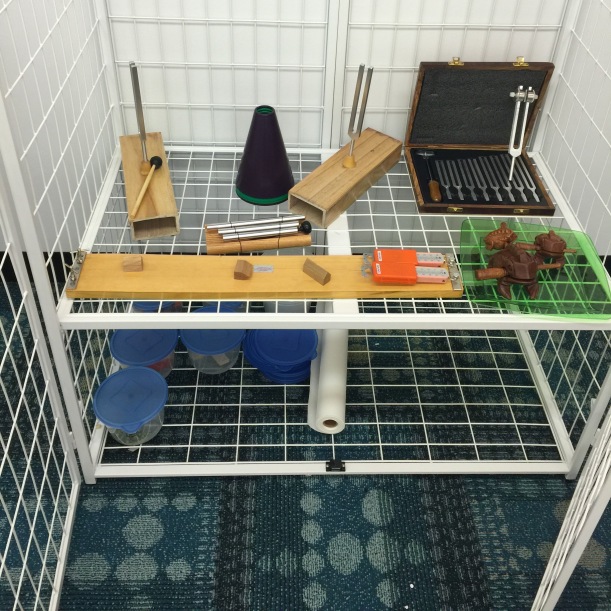It’s a new month, and that means a new theme in the Wonder Ground (NPLD’s STEAM learning zone). February is sound month, and we’re encouraging kids to use their ears to open their minds. Here’s what the room looks like at the moment:
The Big Pegboard

The Pegboard offers lots of information, books, and interactives for exploring the science of sound.
The Cage

Here are the goodies we keep in the Cage. They can’t keep their hands out of here. I love it!
The Big Idea Board

What’s the Big Idea?
Each month we derive the Open Lab activity from one “Big Idea”. I post all the Big Ideas on the board at the beginning of the month. I open and close each 20 minute session by introducing, and revisiting, the BI of the week. As the weeks progress, I link the current BI to the previous week’s BI, if applicable. But I have found that it is better to ere on the side of caution when it comes to opening with too much information. Since we only have twenty minutes, and some of the kids are as young as 6, it helps to keep my babbling to a minimum. I didn’t start out doing this. At first, I found myself talking a mile a minute, over-explaining everything, and asking too many questions. I think this confused the kids, and put them on edge. What’s more, it was difficult for me to be consistent with each group.
In December, when were learning about light and optics, I started paring down my jabber. My friend Jen, a science ed trainer at the UofC, gave me the Talk Science Primer. This article offers a set of 9 “talk moves” designed to facilitate productive science discussions in classrooms. The talk moves aren’t a perfect fit for a library setting; but they gave me some powerful tools for improving the Open Lab flow.
I made an effort to speak calmly, clearly, and simply. And I stuck as close to the simple language used in the BIs as possible. Then I introduced the activity, demonstrated the steps, and let them get to it. Something wonderful happened the first time I used this format: the activities did the talking for me. The kids started finding the evidence, and backing up the BIs with their own experiences. They talk to each other more, and bounce ideas off one another. They focus on what they see unfold in front of them, rather than my expectations or their performance. It’s awesome.
I really love the Big Idea board. I refer to it all the time. And as the weeks go by, I have begun to notice the kids referring to it more and more. Sometimes, I spot a kid taking a break from the activity, staring up at BI board. I see her lips moving and her brow crinkling, and realize, “OMG! SHE’S READING THE BIG IDEAS! MAYBE SHE’S COMMITTING THEM TO MEMORY! YAY!”
The Niles Buzz Blog
Each week I write a post called “This Week In the Wonder Ground”. I was struggling with this at first. I wanted to write something short and sweet, and I would sit in front of my computer paralyzed. I went to my brilliant buddy/coworker, Deidre Winterhalter (@winterstacker), and begged for help. In about 30 minutes she wrote a post that captured the Open Lab experience with just the right amount of detail, and plenty of enthusiasm. My brain immediately sung with joy. What she had written provided the perfect template for future posts. I would never be able to get these done each week if it wasn’t for her brilliantly simple, straightforward, no-nonsense format. Now, these posts take about 20 minutes, 30 if I am included pictures or other media. They go like this:
This week’s Big Idea: blah blah blah.
Activity: We challenged the kids to do/think/try testing the big idea. We passed out a variety of whats-its. We went around the room, and each kid showed us the whats-it he chose. Next, we spread out the other materials we were using on the table. Then we used the materials in such a way that they helped us explore the Big Idea. We documented of the results.
Next week’s Big Idea: yadda yadda yadda.
I’m kinda kidding, but it really is that simple. It is SO EASY to write using this format. I think thankful thoughts about Deidre every week as I am writing them. Check out the most recent: This Week in the Wonder Ground.
If you want to read about our weekly activities and Open Labs, I will post links on this blog.
